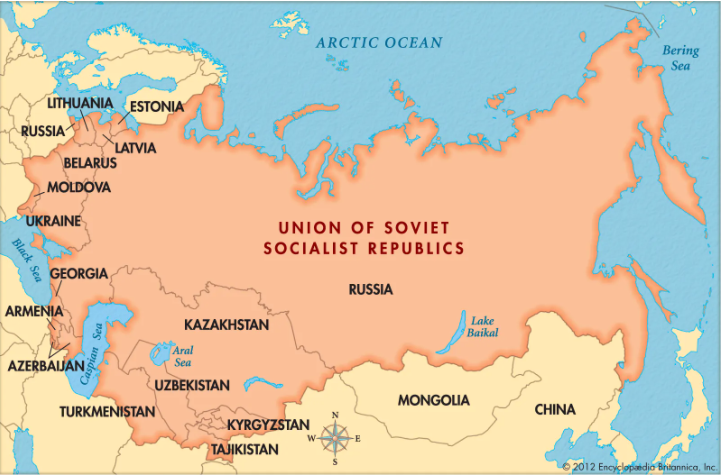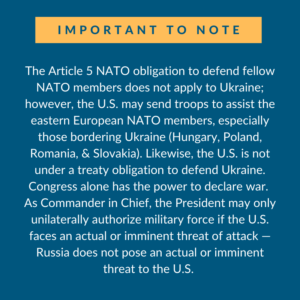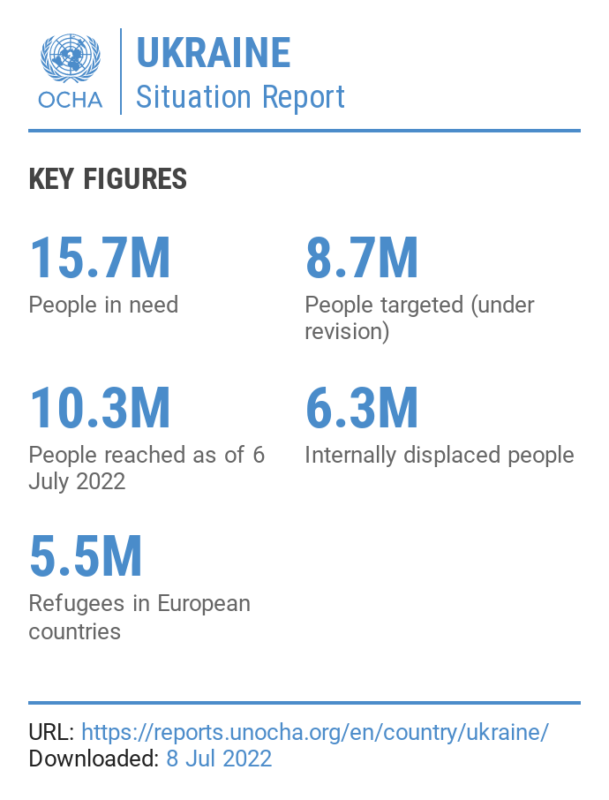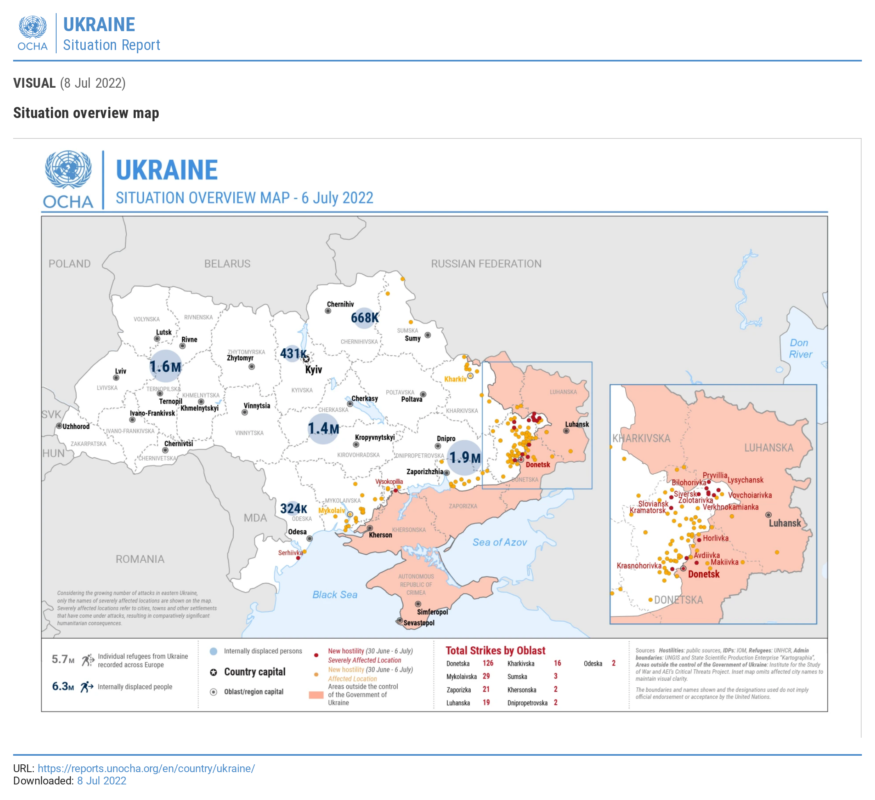A closer look at the Ukraine-Russia crisis.
The Ukraine-Russia Crisis: Virtual Policy Circle Briefings
The Policy Circle conducted several interviews with Ukraine-Russian relation experts and thought leaders to take a deep dive into the escalating crisis between the two countries.
View the Executive Summary for this brief.
Background
The United States has long been referred to as the “indispensable nation” or the “world’s policeman.” Since World War II, America has promoted democracy and prosperity, and opposed dictatorships and human rights abuses across the globe through its economic, diplomatic, and military engagement. The U.S. has served as a champion of universal freedom and human rights, a pillar of international security and order, and a deterrent to the aggression of rogue regimes.
On the opposite side of the spectrum is isolationism, a policy of avoiding interference in the disputes and affairs of other nations. This has also been a recurring theme shaping America’s foreign policy. Particularly in the post-Cold War era, the question of what role the U.S. should play on the world stage, and the extent to which the U.S. can serve as “the world’s policeman,” continues to be debated, and has become a central component in conversations surrounding military spending and foreign policy.
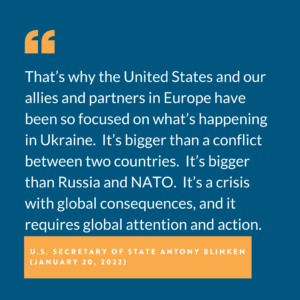
Timeline
In order to better understand the current Ukraine-Russia conflict, it’s helpful to take a step back and explore some of the events in the region since the 1991 collapse of the Soviet Union, officially known as the Union of Soviet Socialist Republics (USSR).
1991: Collapse of the Soviet Union
Ahead of the collapse, the 15 republics (Armenia, Azerbaijan, Belarus, Estonia, Georgia, Latvia, Lithuania, Kazakhstan, Kyrgyzstan, Moldova, Tajikistan, Turkmenistan, Ukraine, Uzbekistan, and Russia) that made up the USSR declared themselves to be sovereign states in 1990.
After the collapse, Ukraine inherited the world’s third-largest nuclear arsenal from the Soviet Union.
Shortly after gaining independence, relations began between Ukraine and the North Atlantic Treaty Organization (NATO), the political and military alliance founded in 1949.
Today, NATO has 30 member countries (America, Canada, and 28 European countries). Ukraine is a NATO partner but not a member — meaning the collective defense principle (commonly referred to as Article 5 of NATO’s founding treaty), which states an attack against one member is considered as an attack against all members, does not apply to Ukraine. However, four countries bordering Ukraine are NATO members: Hungary, Poland, Romania, and Slovakia.
1994: Ukraine Signed Away Its Nuclear Arsenal
Ukraine signed an agreement with Russia, the U.S. and U.K called The Budapest Memorandum, pursuant to which Russia, the U.S. and U.K agreed “to respect the independence and sovereignty and the existing borders of Ukraine” and “to refrain from the threat or use of force” against Ukraine.
In exchange, Ukraine joined the Treaty on the Non-Proliferation of Nuclear Weapons (NPT) as a non-nuclear weapon state, and agreed to send its nuclear weapons to Russia for dismantling.
2014: Russian Seizure of the Crimean Peninsula from Ukraine
Three months of anti-government protests erupted after Ukraine’s then-President Viktor Yanukovych refused to sign an EU association agreement, arguing that Ukraine could not afford to sacrifice trade with Russia. He was then ousted from office and fled to Russia (with Russia’s help), creating an opportunity for pro-Russia separatist rebels to seize territory in eastern Ukraine.
In the biggest land grab in Europe since World War II, Russia’s military invaded part of southern Ukraine and illegally annexed the Crimean Peninsula from Ukraine. Following the invasion, 97% of voters opted to secede from Ukraine and join Russia in an internationally disputed referendum,
Both the United States and the European Union issued statements calling the referendum illegal, illegitimate, and contrary to both the Ukrainian Constitution and international law.
In response to Russia’s annexation of Crimea and violations of the 1994 nuclear agreement, NATO suspended practical civilian and military cooperation with Russia. NATO still maintains open dialogue with Russia.
Shortly after the invasion of Crimea, a separatist conflict erupted between Russian-backed separatists and the Ukrainian army along Ukraine’s eastern border in an area known as the Donbas. To date, over 14,000 people have been killed as a result of the conflict.
2021: Tensions Rise Along the Russia-Ukraine Border
In March, Russia began to send troops and offensive weaponry near the Ukraine border, sparking concern by Western governments. By April, Russia had amassed more military at the borders of Ukraine than it had since the 2014 invasion.
By mid-November, Ukrainian President Volodymyr Zelensky claimed that Russia amassed nearly 100,000 troops near Ukraine’s borders. During a November 30 press conference, NATO Secretary General Jens Stoltenberg warned that allies must “prepare for the worst” in Ukraine.
Russian President Vladimir Putin’s goal is to maintain a sphere of influence across the entire former Soviet Union territory with Russia at the helm. He wants legally enforceable assurances that NATO will stop eastward expansion and deny membership to Ukraine.
In 2008, Ukraine requested a NATO membership action plan and NATO said it will become a member, but did not offer a timeline and there has been no consensus on granting membership. Ukraine is a NATO partner country, which means that it cooperates closely with NATO, but it is not covered by the collective defense guarantee in the Alliance’s founding treaty.
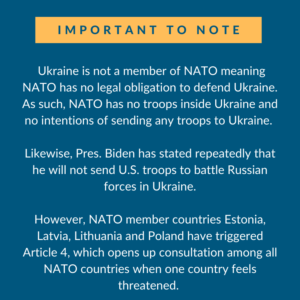
Russia also wants removal of NATO troops and military equipment, including intermediate-range missiles, in eastern Europe, and an end to the fighting between Russian-backed separatist forces and Ukraine’s army in eastern Ukraine. Pres. Putin has threatened a “retaliatory military-technical” response if his demands are not met.
Both the U.S. and NATO are committed to a sovereign, safe, and stable Ukraine, and have rejected Russia’s demands, promising economic sanctions and a beefed-up NATO presence in eastern Europe if Russia further invades Ukraine.
2022
January
By late January, Russia had amassed over 130,000 troops near the Ukraine border – that is about 30,000 more than the number of U.S. troops in Afghanistan during the peak of the war. Pres. Putin denied accusations about its intention to launch an attack on Ukraine and said the military buildup near Ukraine was needed to protect its borders.
Speaking on January 23, Secretary of State Antony Blinken said the U.S. is building up its defense while it’s engaged in diplomacy and dialogue. “We’re building up deterrence. We’ve now provided to Ukraine more security assistance this year than in any previous year. We have rallied allies and partners around the world. We are preparing massive consequences for Russia if it invades Ukraine again,” he said.
On January 24, Pentagon Press Secretary John Kirby announced that 8,500 U.S. troops were placed on heightened alert as part of a NATO operation for possible deployment to NATO countries in eastern Europe if NATO activates the NATO Response Force (NRF), which is made up of 40,000 multinational troops, or “if other situations develop.”
February
On February 2, Secretary Kirby announced plans to send about 2,000 troops to Poland and Germany, and approximately 1,000 to Romania to “ensure the robust defense of our NATO allies” — not to fight in Ukraine. Kirby said the U.S. will continue to coordinate with our European allies and work through NATO to make sure that deployment efforts compliment each other, and are “appropriate, defensive, and non-escalatory.”
As Russian officials accused the U.S. and our allies of causing hysteria by exaggerating the threat of a Russian invasion in order to drive a wedge between Russia and Ukraine, the Biden administration continued to consult with our European allies about possible economic sanctions against Russia should it invade Ukraine.
Another piece of the sanctions puzzle is Russian gas, and the Nord Stream 2, the new 764-mile natural gas pipeline running under the Baltic Sea from western Russia to northeastern Germany, which is owned by a Russian state-owned company. The controversial pipeline, which was opposed by the U.S., Ukraine, and Poland, could potentially be operational by summer, but Germany halted the project on February 22. With Europe receiving about 40% of its natural gas from Russia, Russia’s ability to cut off supply could cause a European gas (and economic) crisis.
The Policy Circle’s 2021 Leadership Summit focused on this very topic and shined a light on the need to diversify energy sources. For more information, see The Policy Circle’s Energy & The Environment Brief or watch the Summit panel on Unpacking the Energy Industry.
Russian President Vladimir Putin joined Chinese President Xi Jinping in Beijing ahead of the 2022 Winter Olympics. In a show of unity, they issued a joint statement whereby China indicated it agrees with Russia’s opposition for any enlargement of NATO – including for Ukraine. Russia, in turn, confirmed its agreement with China’s stance “that Taiwan is an inalienable part of China, and opposes any forms of independence of Taiwan.” Both leaders stated they “remain highly vigilant about the negative impact of the United States’ Indo-Pacific strategy on peace and stability in the region.”
In a significant shift, Ukrainian President Volodymyr Zelenskyy took to Facebook to prepare his people that an invasion by Russia will likely take place on Feb. 16. Echoing Zelenskyy’s warning, Defense Department Press Secretary John Kirby said Pres. Putin “is doing all of the things that you would expect him to do to make sure that he’s ready for that option.” In response, Secretary of State Antony Blinken announced the U.S. is continuing “diplomatic efforts to deescalate the crisis” while temporarily relocating the remaining embassy presence in Ukraine from Kyiv to Lviv (which is close to the Poland border).
Days after Secretary Blinken told the U.N. Security Council that Russia will manufacture a pretext for its attack, such as a violent event that Russia will blame on Ukraine, and then respond to the manufactured provocation via a declaration that Russia must defend Russians in Ukraine, Pres. Putin signed a decree recognizing two separatist-controlled regions (Donetsk and Luhansk) in an area of eastern Ukraine known as the Donbas as independent and ordered Russian troops to those territories in what the Kremlin is calling a “peacekeeping” mission.
In a live televised speech that aired before 6 a.m. local time on February 24, Pres. Putin declared a “special military operation” to protect civilians in eastern Ukraine in a declaration of war. He issued a warning to the Ukrainian military to “immediately put down arms and go home” and cautioned any nations that consider intervening will face consequences “never seen in history.” Immediately afterwards, explosions were reported in the eastern, southern, and northern parts of Ukraine, including in the capital city Kyiv. A series of cyberattacks on Ukrainian government websites followed.
As every Ukrainian faced the impossible decision of whether to flee their home in attempt to secure safety for their family or take up arms to fight for their country, Ukrainian Pres. Zelenskyy declared martial law and ordered a full military mobilization.
The international criminal court (ICC) in The Hague announced it will launch an investigation into possible war crimes or crimes against humanity in Ukraine.
One day after Pres. Zelenskyy officially signed an application for Ukraine’s membership in the European Union, he delivered a powerful speech to the European Parliament making the case for Ukraine’s immediate membership. Watch it (with subtitles) here.
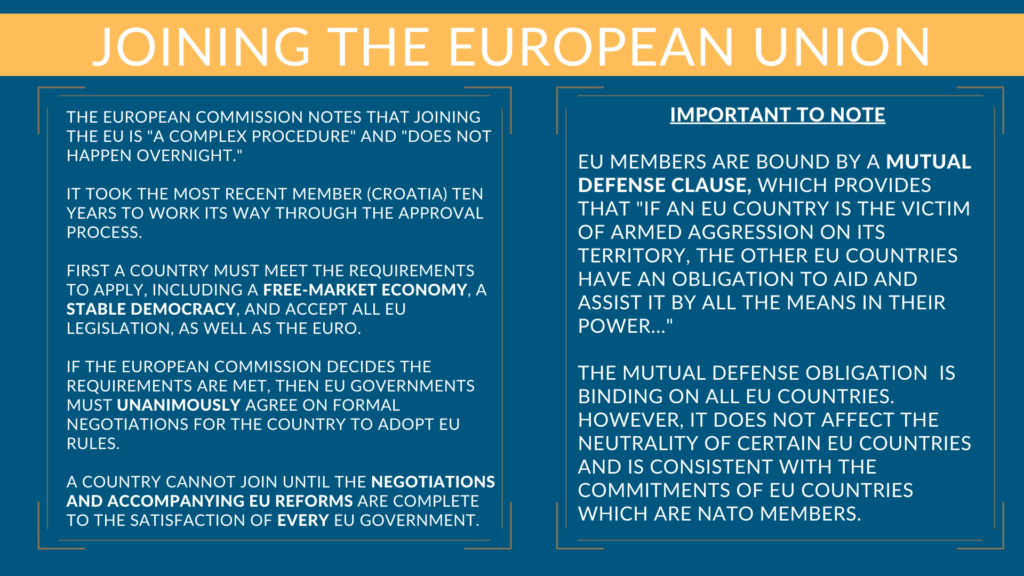
Current Crisis & Latest Information
- Key Facts
- Ukraine Civilian Casualties as of July 4: 4,889 killed (including at least 335 children) and 6,263 injured (including at least 521 children)
For daily updates on Russia’s invasion of Ukraine, check out some of our must trusted sources:
- AP News
- AllSides
- Institute For The Study of War
- UN: Ukraine
- UN High Commissioner for Refugees: Ukraine Refugee Situation
What You Can Do
The following organizations are working to provide food, water, medical care, emergency supplies, cash assistance, hygiene kits, and ongoing support to those who remain in Ukraine and those displaced by the conflict:
“Your emergency gift supports CARE’s Ukraine Crisis Fund to reach 4 million with immediate aid and recovery, food, water, hygiene kits, psychosocial support, and cash assistance — prioritizing women and girls, families, and the elderly.”
Doctors Without Borders / Médecins Sans Frontières (MSF)
“MSF teams remain in Ukraine and are currently seeking ways to respond to the medical and humanitarian needs as the conflict evolves. We are also mobilizing our staff and resources internationally to be ready for a variety of potential needs. Our supply centers are currently preparing medical kits for rapid dispatch. We have sent additional emergency teams to the region, and our staff are currently assessing the needs of Ukrainian refugees in Poland and other neighboring countries.”
International Committee of the Red Cross (ICRC)
“The ICRC has been working in Ukraine since 2014. Our operations in the country are among the ten largest ICRC operations worldwide with a team of over 600 staff members. Working closely with the Ukrainian Red Cross Society, we are increasing our response to the humanitarian needs in Ukraine. Our support to people includes emergency assistance such as food, water, and other essential items. We also support hospitals and primary healthcare facilities with medical equipment and emergency preparedness. We repair water stations and support households to rehabilitate their damaged homes. We also help families separated by the conflict reconnect.”
“International Medical Corps is expanding its relief efforts inside Ukraine in response to the war there, as well as in neighboring countries, to provide medical, mental health and protection services to the millions of people affected by the conflict, including refugees.”
International Rescue Committee
“The IRC is on the ground in Poland supporting displaced children and families with vital supplies. Your gift will help us provide food, medical care and emergency support services to refugee families in countries like Ukraine, Afghanistan, Syria, and Yemen.”
“Hospitallers is a volunteer organization of paramedics. It was founded by Yana Zinkevich at the beginning of hostilities in Ukraine in 2014. Then Russia annexed Crimea and began hostilities in the east of the country. The slogan of our organization is ‘For the sake of every life.’ And hospitallers prove every day that for us these are not just words.”
“Ukraine is facing an unprecedented attack. The Kyiv Independent continues to work, bringing the world trusted, important information about the facts on the ground. We need your support in this difficult and unpredictable task. From cyberattacks, bombings, ground invasions – it is hard to predict what the days ahead will bring and what we will need to respond. All this is a huge trial for a media launched just 3 months ago. But together we can overcome.”
The National Bank of Ukraine has special two fundraising accounts: one support the Armed Forces of Ukraine and another designated for humanitarian needs.
“Razom is a non-profit Ukrainian-American human rights organization established to support the people of Ukraine in their pursuit of a democratic society with dignity, justice, and human and civil rights for all.”
Save the Children’s Ukraine Crisis Relief Fund
“Save the Children is concerned for children caught in the middle of armed conflict, forced from their homes in freezing temperatures, and exposed to injury, hunger and cold. Your donation to Save the Children’s Ukraine Crisis Relief Fund can help provide children and families with immediate aid, such as food, water, hygiene kits, psychosocial support and cash assistance. Together, we can protect children in crisis.”
“Spirit of America is working closely with US military and State Department personnel in Poland to meet the urgent needs of Ukraine’s Armed Forces on the front lines. We are providing medical supplies and equipment, including first aid kits, for Ukrainian soldiers and field medical personnel. We expect to provide emergency communications gear. We are also working with US Special Operations Forces to provide emergency assistance to Ukrainians displaced by the fighting.”
“All funds will be used to help those in need, affected by armed conflict, blood collection, mobilization of volunteers and resources, and emergency activities.”
United Nations Refugee Agency (UNCHR)
“UNHCR is on the ground scaling its response to provide assistance and ensure those displaced find safety in welcoming arms in this moment of crisis. Resources are stretched thin, and your kindness is needed to help restore lives in Ukraine and wherever families have been displaced. Your compassionate support can help ensure that the moment an emergency hits — whether in Ukraine, Afghanistan, Ethiopia or beyond — UNHCR is on the ground providing emergency supplies, lifesaving care and hope. You can help ensure that families fleeing violence around the world know they are not alone at the most devastating moment of their lives.”
United Nations World Food Programme
“The United Nations World Food Programme is on the ground right now providing critical food assistance for people fleeing the conflict. With your help, we can deliver food directly to Ukrainian people in dire need.”
“WCK uses the power of food to nourish communities and strengthen economies in times of crisis and beyond. When disaster strikes, WCK’s Chef Relief Team mobilizes to the front lines with the urgency of now to start cooking and provide meals to people in need. WCK’s resilience work advances human and environmental health, offers access to professional culinary training, creates jobs, and improves food security for the people we serve.”
Find and contact your member in the U.S. House of Representatives to learn about their take on America’s role in NATO and the Ukraine-Russia conflict.
Additional Resources
Council on Foreign Relations: Conflict in Ukraine
Department of State: Fact vs. Fiction: Russian Disinformation on Ukraine
Lawfare: Revisiting Ukraines Nuclear Past Will Not Help Secure its Future
Center for Strategic and International Studies: Russia’s Possible Invasion of Ukraine
Congressional Research Service: Russian Political, Economic, and Security Issues and U.S. Interests
